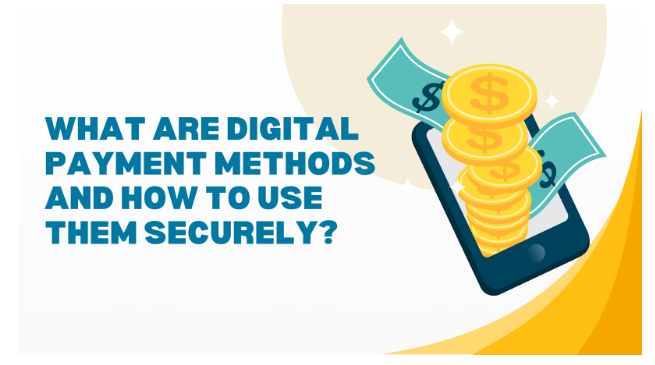In the fast-evolving landscape of financial transactions, digital payment methods have become an integral part of our daily lives. These payment methods, driven by advancements in technology, allow individuals and businesses to transfer money electronically, providing convenience, speed, and efficiency. While digital payments offer numerous benefits, it is essential to use them securely to avoid potential risks such as fraud and data breaches. This article explores what digital payment methods are, their types, and how to use them safely.
Understanding Digital Payment Methods
Digital payment methods refer to transactions that occur through electronic means, eliminating the need for physical cash or checks. These methods leverage internet connectivity, mobile networks, and digital interfaces to facilitate payments between parties. They are designed to make payments more accessible, whether for online shopping, bill payments, or peer-to-peer transfers.
The adoption of digital payment methods has surged in recent years, fueled by the rise of e-commerce, smartphone penetration, and supportive government policies promoting cashless economies. Today, digital payments are not only limited to urban centres but are also reaching rural areas, bridging financial inclusion gaps.
Types of Digital Payment Methods
Digital payment methods come in various forms, each catering to different needs and preferences. Some of the most common types include:
1. Credit and Debit Cards
Credit and debit cards remain one of the most widely used digital payment methods. These plastic cards allow users to make purchases online and offline by swiping or entering card details on payment gateways. Credit cards enable borrowing within a limit, while debit cards deduct money directly from the user’s bank account.
2. Mobile Wallets
Mobile wallets, such as PayPal, Google Pay, and Apple Pay, store payment information digitally, enabling users to make payments through their smartphones. These wallets offer features like QR code scanning, contactless payments, and seamless integration with apps and websites.
3. Online Banking
Internet banking facilitates payments directly from bank accounts via a secure online portal. Customers can transfer funds, pay bills, and manage their finances using this method.
4. UPI (Unified Payments Interface)
UPI has revolutionized peer-to-peer and peer-to-merchant payments in countries like India. It allows users to transfer money instantly using their smartphones, relying on virtual payment addresses (VPAs).
5. Cryptocurrencies
Cryptocurrencies like Bitcoin and Ethereum have emerged as alternative digital payment methods. Operating on blockchain technology, these payments offer decentralized and secure transactions but are subject to regulatory scrutiny in many countries.
6. Digital Payment Apps
Applications such as Venmo, Zelle, and Cash App specialize in instant transfers and splitting bills. These apps are particularly popular among younger demographics.
7. Contactless Payments
Contactless payment methods use near-field communication (NFC) technology to enable users to pay by tapping their cards or devices on payment terminals. This method is convenient and hygienic, especially in post-pandemic scenarios.
Benefits of Digital Payment Methods
1. Convenience
Digital payments eliminate the need to carry cash or visit physical locations for transactions. They enable instant payments, accessible anytime and anywhere.
2. Speed
Most digital payments are processed in real time, making them ideal for urgent transactions and reducing delays.
3. Cost-Effectiveness
Digital payments often incur lower fees compared to traditional methods, particularly for international transfers.
4. Enhanced Record-Keeping
These methods provide digital records of transactions, simplifying budgeting and accounting for both individuals and businesses.
5. Financial Inclusion
Digital payments empower underserved communities by offering access to financial services through mobile phones and internet connectivity.
Risks Associated with Digital Payment Methods
While digital payment methods are secure, they are not immune to risks. Common vulnerabilities include:
- Phishing Attacks: Fraudsters trick users into revealing sensitive information through fake emails or messages.
- Data Breaches: Cybercriminals may target payment systems to steal card details or personal data.
- Unauthorized Transactions: Lost or stolen devices can lead to unauthorized access to digital wallets or payment apps.
- Malware and Viruses: Malicious software can compromise devices used for digital payments.
How to Use Digital Payment Methods Securely
To enjoy the benefits of digital payments while minimizing risks, follow these best practices:
1. Use Strong Passwords
Ensure all digital payment accounts and devices are protected with strong, unique passwords. Avoid using easily guessable information like birthdays or names.
2. Enable Two-Factor Authentication (2FA)
Two-factor authentication adds an extra layer of security by requiring a second form of verification, such as a one-time password (OTP) or biometric authentication.
3. Keep Software Updated
Regularly update your smartphone, apps, and operating systems to ensure you have the latest security patches.
4. Avoid Public Wi-Fi for Transactions
Public Wi-Fi networks are often unsecured, making them a hotspot for hackers. Use a virtual private network (VPN) if you must perform transactions on public networks.
5. Verify Authenticity
Be cautious when clicking on links or downloading apps. Only use official websites and app stores to access digital payment platforms.
6. Monitor Transactions Regularly
Review your bank and digital wallet statements frequently to identify unauthorized or suspicious transactions.
7. Secure Your Devices
Set up screen locks, use antivirus software, and enable remote wipe options on your devices to protect sensitive data in case of loss or theft.
8. Beware of Phishing Scams
Do not share OTPs, PINs, or passwords with anyone, even if they claim to be from your bank or a trusted entity. Always verify requests independently.
9. Limit Sharing of Personal Information
Provide only the necessary details during transactions and avoid oversharing personal information on unverified platforms.
Future of Digital Payments
The digital payment landscape continues to evolve, driven by innovations such as blockchain, artificial intelligence, and biometric authentication. Emerging trends include:
- Voice-Activated Payments: Payments are initiated through voice commands on virtual assistants like Alexa and Siri.
- Wearable Payment Devices: Smartwatches and fitness bands with payment capabilities.
- Biometric Payments: Fingerprint and facial recognition-based authentication for transactions.
- Cross-Border Payment Solutions: Enhanced systems for seamless and cost-effective international payments.
These advancements aim to make digital payments more intuitive, secure, and inclusive.
Conclusion
Digital payment methods have transformed the way we transact, offering unparalleled convenience and efficiency. From credit cards and mobile wallets to cryptocurrencies, the array of options continues to expand, catering to diverse needs. However, the growing reliance on digital payments also underscores the importance of using them securely. By adopting robust security practices such as enabling two-factor authentication, updating software, and staying vigilant against phishing scams, users can safeguard their financial information and enjoy the benefits of a cashless economy with confidence. As technology continues to advance, digital payments will play an even more significant role in shaping the future of commerce and financial inclusion.




